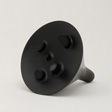One day, in the future, robots will do everything for us. It's a dream
that refuses to go away. Over the coming years, robots are destined to
play a significant part in our daily lives -- not as super smart,
functional machines, nor as pseudo life forms, but as technological
cohabitants. But how will we interact with them? What new
interdependencies and relationships might emerge in relation to
different levels of robot intelligence and capability? These objects
are meant to spark a discussion about how we'd like our robots to
relate to us: subservient, intimate, dependent, equal?
Robot 1: This one is very independent. It lives in its own world getting on with its work. We don?t really need to know what it does as long as it does it well. It could, for instance, be running the computers that manage our home. It has one quirk; it needs to avoid strong electromagnetic fields as these might cause it to malfunction. Every time a TV or radio is switched on, or a mobile phone is activated it moves itself to the electromagnetically quietest part of the room. As it is ring shaped, the owner could, if they liked, place their chair in its centre, or stand there and enjoy the fact that this is a good space to be in.
Robot 2: In the future products/robots might not be designed for specific tasks or jobs. Instead they might be given jobs based on behaviours and qualities that emerge over time. This robot is very nervous, so nervous in fact, that as soon as someone enters a room it turns to face them and analyses them with its many eyes. If the person approaches too close it becomes extremely agitated and even hysterical. Home security makes good use of this robot?s neurosis.
Robot 3: More and more of our data, even our most personal and secret information, will be stored on digital databases. How do we ensure that only we can access it? This robot is a sentinel, it uses retinal scanning technology to decide who accesses our data. In films iris scanning is always based on a quick glance. This robot demands that you stare into its eyes for a long time, it needs to be sure it is you. On another level, it asks what new forms of furniture might evolve in response to future technological developments.
Robot 4: This one is very needy. Although extremely smart it is trapped in an underdeveloped body and depends on its owner to move it about. Neediness is designed into very smart products to maintain a feeling of control. Originally, manufacturers would have made robots speak human languages, but over time they will evolve their own language. You can still hear human traces in its voice.
Curated/Commissioned by Jan Bolen z33
Video: Noam Toran
Robot Sound Design: Scanner
Computer Modelling: Graeme Findlay
Thanks to: Per Tingleff, Ben Legg, James Auger, Simon Denzel, Bahbak Hashemi-Nehzad, Wakana and Mo.
The Robots are in the permanent collections of MoMA, New York, and Fnac -- Fond national d'art contemporain, Paris.
Robot 1: This one is very independent. It lives in its own world getting on with its work. We don?t really need to know what it does as long as it does it well. It could, for instance, be running the computers that manage our home. It has one quirk; it needs to avoid strong electromagnetic fields as these might cause it to malfunction. Every time a TV or radio is switched on, or a mobile phone is activated it moves itself to the electromagnetically quietest part of the room. As it is ring shaped, the owner could, if they liked, place their chair in its centre, or stand there and enjoy the fact that this is a good space to be in.
Robot 2: In the future products/robots might not be designed for specific tasks or jobs. Instead they might be given jobs based on behaviours and qualities that emerge over time. This robot is very nervous, so nervous in fact, that as soon as someone enters a room it turns to face them and analyses them with its many eyes. If the person approaches too close it becomes extremely agitated and even hysterical. Home security makes good use of this robot?s neurosis.
Robot 3: More and more of our data, even our most personal and secret information, will be stored on digital databases. How do we ensure that only we can access it? This robot is a sentinel, it uses retinal scanning technology to decide who accesses our data. In films iris scanning is always based on a quick glance. This robot demands that you stare into its eyes for a long time, it needs to be sure it is you. On another level, it asks what new forms of furniture might evolve in response to future technological developments.
Robot 4: This one is very needy. Although extremely smart it is trapped in an underdeveloped body and depends on its owner to move it about. Neediness is designed into very smart products to maintain a feeling of control. Originally, manufacturers would have made robots speak human languages, but over time they will evolve their own language. You can still hear human traces in its voice.
Curated/Commissioned by Jan Bolen z33
Video: Noam Toran
Robot Sound Design: Scanner
Computer Modelling: Graeme Findlay
Thanks to: Per Tingleff, Ben Legg, James Auger, Simon Denzel, Bahbak Hashemi-Nehzad, Wakana and Mo.
The Robots are in the permanent collections of MoMA, New York, and Fnac -- Fond national d'art contemporain, Paris.






























